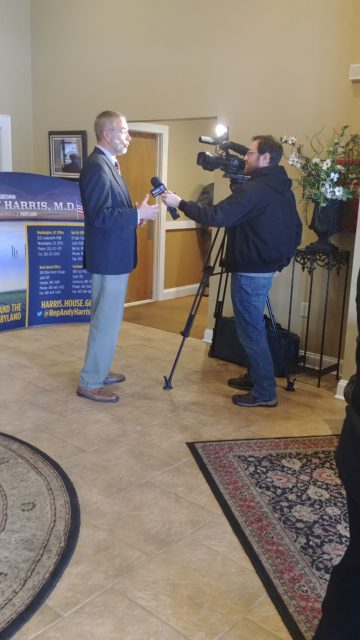I noticed on the news the other day that my home state of Ohio had its proposed Congressional redistricting map tossed out by a 4-3 Ohio Supreme Court ruling, with the Republican chief justice joining the three Democrat justices in claiming the map was, “a plan that is infused with undue partisan bias and that is incomprehensibly more extremely biased than the 2011 plan that it replaced.”
I’m going to be the first to admit that the Ohio Republicans in 2010, after being infused with the energy of the TEA Party, made it their mission to wipe out Democrat representation. One memorable piece of gerrymandering was shoestringing the Toledo-based Ninth Congressional District (my former home district) along the south shore of Lake Erie to the edge of Cleveland in order to place two Democrat representatives, Marcy Kaptur and Dennis Kucinich, in the same district. When both sought the seat in 2012, Kaptur prevailed and all but ended Kucinich’s political career.
So the Republicans have to go back to the drawing board, and in an interesting twist of state law, maps that pass without bipartisan support may only be left in place for four years. And the Ohio ruling gave yet more ammunition to Democrats to claim we need a national standard – enter my old uber-regressive friend Rick Weiland, who e-mailed me to say:
Republicans are only months away from rigging a decade of elections.
(snip)
In 2016, the Democratic governor of North Carolina won re-election with 51% of the vote, the same year Donald Trump won the presidency with slightly less than 51%. Yet, even though Democrats are winning approximately 50% of the votes statewide, they’re still ending up in a permanent minority in the state legislature.
Thanks to all of our hard work, Georgia has become a quintessential battleground state. But thanks to Republican gerrymandering, Republicans are expected to win 9 or 10 of Georgia’s 14 congressional seats. In Gwinnett County, Georgia, which has seen its demographics shift from 90% white in 1990 to 30% white today, this is not at all recognized by the maps drawn by the Republican-controlled legislature.
And, in Ohio, where Republicans win about 53% of the vote, the GOP is favored to win 80% of congressional seats.
“Freedom to Vote Act would ban partisan gerrymandering,” e-mail from Rick Weiland, January 11, 2022.
You can throw out that last sentence for the moment. But let’s talk about how people vote, and I’m going to take a look at Maryland for the moment because, unlike Delaware, they actually have Congressional districts.
In the last three Congressional elections, this is the share of the aggregate Congressional vote each party has received in the state of Maryland.
- 2020: Democrats 64.7%, Republicans 34.8%, others 0.4%
- 2018: Democrats 65.3%, Republicans 32.3%, others 2.4%
- 2016: Democrats 60.4%, Republicans 35.5%, others 4.0%
In that time period, Democrats have held consistent around 55% of registered voters, while the GOP slipped slightly but stayed around 25%. Given that ratio one can assume unaffiliated voters split roughly 50-50, although in 2016 it looks like they tilted somewhat toward the GOP and slightly favored Democrats in 2018. (Another factor: there were fewer third party aspirants on the 2020 ballot, as the Libertarians and Greens didn’t field candidates. That may have had something to do with ballot access issues for the minor parties in Maryland, which has a stricter criteria for access than Delaware does.)
To make a long story short, in a given election between two candidates statewide in Maryland the split should run 65-35 in favor of the Democrats – in fact, 2020 was a perfect example of this. However, when you split the state into districts you’ll find that there are pockets of heavier Republican registration, and in 2010 the Democrats (who control redistricting) chose to pack as many Republican stalwarts as possible into the First District by switching portions of GOP-dominated Carroll County into the First and burying the rest in a tide of MoCo Democrats by placing it in the Eighth. This was done in order to swamp the formerly-Republican Sixth District in a separate crush of MoCo Democrats by eliminating its Frederick and Carroll county portions and instead thrusting it further into MoCo. (And as I’ll note momentarily, it worked.)
In the 2010 district map, centrist Anne Arundel County was mercilessly jigsawed into four different districts, while the more populous Democrat enclaves of Baltimore City and Montgomery County were sliced into three and Prince George’s into a hacksawed two based on the party’s need for dominance, maintaining through the decade a 7-1 advantage gained when the Sixth District flipped from Republican to Democrat thanks to the additional leftist MoCo voters. Once the map was approved, all but one of the changes in Maryland’s Congressional delegation during the decade came from retirement or death, as the only incumbent to lose at the ballot box was Sixth District Republican Roscoe Bartlett in 2012 – the chosen victim of Democrat redistricting. The same occurred in 2002 after that round of Democrat-controlled redistricting, when the Second District seat previously held by Bob Ehrlich (who won his run for governor) and Eighth District seat held by Connie Morella (who lost a re-election bid) flipped, changing Maryland from a 4-4 state to a 6-2 Democrat state. Aside from the Democrats gaining the First District for a term with Frank Kratovil in 2008 before he lost to Andy Harris, that’s the way it stayed.
This time around it’s the aforementioned Republican Andy Harris who is the target of Democrats, as they opted to not pack Republicans into the First and instead brought it back close to the configuration that gave the First District Kratovil in 2008 as part of Anne Arundel was once again placed in the First. (Additionally, Harris no longer lives in the district, which is now completely outside his home in Baltimore County.) Anne Arundel gets a slight break this time, though, as they are only in three districts, as is Baltimore City. MoCo now has the distinction of being cut in jagged fourths by the map.
By comparison, the map presented by Governor Larry Hogan’s redistricting committee (made up of equal portions Republicans, Democrats, and independents) came up with a Congressional map that respected county boundaries as much as possible. No county was chopped into more than three districts: in Baltimore County, only the extreme southern tip was placed in the city-centric Seventh District while the rest went into a Second District exclusive to the county and the First District. Meanwhile, Montgomery County had its own district in the Eighth, with a little piece of the western end of the county staying in the Sixth District (as has been traditional) and the rest – a slice along its eastern border – joining the northern half of Prince George’s County in the Fourth District. But since that would likely be a 6-2 Democrat split, it wasn’t good enough for the rabidly partisan General Assembly – never mind that a truly representative state of Maryland would probably shake out as a 5-3 Democrat majority based on their voting pattern.
(As you’ll see in its 160-plus pages, this Hogan redistricting committee proposal also covered state legislative districts, with the key change the elimination of multiple-member Delegate districts. The Democrats hated that, too.)
In circling back to Weiland’s plea – which echoes that of the most rabid Congressional Democrats – one has to wonder where the energy for leading by example went to. What happened to criticism of states like Maryland, Illinois, or California, where Republicans are gerrymandered out of any semblance of power? This is particularly true when Marylanders were presented with an alternative that was more fair.
The problem with pretty much any district map done geographically is that keeping things compact and contiguous means that you get urban areas that vote 90% Democrat (and have enough population for a district of their own) surrounded by suburban and rural areas that swing 70-30 or more the other way. To take a state like Ohio, you could easily get a 10-5 Republican split by just keeping the large three-C (Cincinnati, Columbus, Cleveland) urban counties in their own districts, plus maybe one that combines the Akron/Canton/Youngstown area and one based in Toledo. Just divide the rest of the state 10 ways, and it could pass muster geographically. Move north into Michigan: give the city of Detroit its own district and split up the suburbs into thirds or fourths – those are your D districts in Michigan. Given the size of the other cities in the state, there’s not enough urban area for a Democrat-dominated district.
(Turns out they were pretty close, giving Detroit two districts and the suburbs three, including combining the downriver Detroit suburbs and Ann Arbor area for a third strong D district. But the state is being sued by the “Detroit Caucus” because the city lost a seat from the hack job previously in place.)
Perhaps the best example of this approach is in Nebraska, where one district is basically the city of Omaha and close-in suburbs, another is the Omaha exurbs and the college town of Lincoln, and the third is everything else. In theory, all three representatives could now live within about 25 miles of Omaha – but one would have a heckuva district to cover. (The change from before is that the “rest of the state” district now comes close to Omaha – prior to this year the Lincoln district completely surrounded the Omaha one.)
What I do know is that the solution doesn’t lie in Congress. When the hypocrisy of ignoring the beam in your eye to focus on the speck in your brother’s eye (as described in Matthew 7:3) is so rampant there, they aren’t the answer. If the regressives had their way, districts would pinwheel out of urban areas in just such a manner that centrist and Republican voters would be shut out by their urban counterparts – who would also be in charge of counting the votes, and since urban areas always seem to report last, they would know just the margin of “mail-in votes” they need to create.
This is why Congress should not be in charge of their own elections – it’s bad enough what we sometimes have to put up with at the state level.



